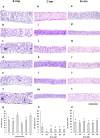Radiation quality matters: morphological and biochemical responses of Brassica rapa microgreens to X-rays, C-ions, and Fe-ions
- PMID: 41071389
- PMCID: PMC12513970
- DOI: 10.1007/s00425-025-04835-6
Radiation quality matters: morphological and biochemical responses of Brassica rapa microgreens to X-rays, C-ions, and Fe-ions
Abstract
Radiation type and dose distinctly modulate microgreens development, revealing trait-specific thresholds where X-rays induce hormesis, carbon ions delay differentiation, and iron ions enhance biochemical balance with moderate anatomical disruption. As space exploration progresses and controlled-environment agriculture becomes increasingly relevant under extreme conditions, understanding how ionizing radiation affects plant development is crucial. Ionizing radiation poses a major constraint in space cultivation systems, also playing a role in terrestrial stress scenarios. Despite growing interest in radiation biology, few studies have systematically compared plant responses to different radiation types with distinct linear energy transfer (LET). In this study, seeds of Brassica rapa L. were exposed to increasing doses of X-rays (low-LET), carbon ions, and iron ions (high-LET). Seed germination, morpho-anatomical, and biochemical traits of plants were assessed up to the microgreens stage. Plant responses were both dose- and radiation-specific. Specifically, X-rays triggered a hormetic response at low doses (1 Gy), with a decline in several analyzed traits at higher doses. Carbon ions increased leaf expansion but reduced the content of pigments, proteins, and the structural investment, suggesting a delayed tissue differentiation and low-cost acclimation mechanism under stress. Iron ions promoted a coordinated upregulation of biochemical defenses and moderate anatomical changes. Overall, radiation quality induced distinct acclimation strategies in B. rapa, influencing the balance between growth, structural integrity, and defense mechanisms, highlighting its notable radioresistance. Moreover, identifying trait-specific thresholds and response patterns suggests that different radiation types could be selectively applied to modulate specific functions (e.g., biomass or antioxidants promotion, anatomical adjustments) based on desired outcomes. These findings provide valuable insights into how different ionizing radiation types impact plant responses, addressing a critical gap in space-oriented research and guiding strategies to optimize plant growth in extraterrestrial environments.
Keywords: Extreme environments; Ionizing radiation; Leaf traits; Phytochemical countermeasures; Radiobiology; Stress response.
© 2025. The Author(s).
Conflict of interest statement
Declarations. Conflict of interest: The authors declare no conflict of interest.
Figures





References
-
- Albarzinji IM, Anwar AM, Karim HH, Ahmed MO (2022) Photosynthetic pigments and stomata characteristics of cowpea (Vigna sinensis Savi) under the effect of X-ray radiation. UHD J Sci Technol 6:58–64. 10.21928/uhdjst.v6n2y2022.pp58-64
-
- Al-Enezi NA, Al-Bahrany AM, Al-Khayri JM (2012) Effect of X-irradiation on date palm seed germination and seedling growth. Emirates J Food Agric 24:415–424
-
- Aneja P, Sanyal R, Ranjan A (2025) Leaf growth in third dimension: a perspective of leaf thickness from genetic regulation to ecophysiology. New Phytol 245:989–999. 10.1111/nph.20246 - PubMed
MeSH terms
Substances
LinkOut - more resources
Full Text Sources
Medical
Research Materials
Miscellaneous

